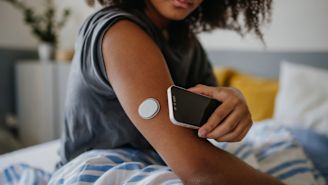Monitoring blood glucose is a key part of diabetes management.
Your healthcare provider (HCP) may want you to track your blood glucose at home. Tracking your blood sugar throughout the day is becoming increasingly easier and less of a hassle as home-testing tools and even smartphone apps ease the process. But doing it appropriately and correctly still requires planning.
Finding the right meter
The first step is to ask your HCP for a prescription for a blood glucose meter that is right for you. Pharmacies sell them, but you’ll want to be sure that your insurance covers the one you’re prescribed.
Other factors besides insurance coverage matter, too. You can ask your HCP how difficult a specific meter is to use and whether the results can be tracked on your computer. If you can’t upload results or send them via a smartphone device, you’ll need to manually record them or enter them into a spreadsheet or online tool.
Other important questions relate to how bulky the meter is and how easy it is to use in situations that are typical for you, such as in a classroom if you’re a student or teacher. Certain additional features—such as audio prompts if you have a hearing impairment or extra-large buttons if you have a visual impairment—may also help you determine if a particular model is right for you. These are important considerations because you will need to have your meter with you at all times.
It’s also a good idea to take a look at the product’s instructions, often available for download from the manufacturer’s website, to find out whether the device is easy for you to use.
Caring for and using your meter
Your HCP can help you learn to use your blood glucose meter properly and ensure a smooth process, from loading a test strip to getting a blood sample to performing a measurement. Steps to keep in mind typically include handwashing, learning the appropriate temperature for testing, ensuring a good blood sample, and calibrating the meter. Because this list might seem daunting, getting help from your HCP is a good idea.
Blood glucose meters and related supplies, such as test strips, need proper care. They should not be subjected to extreme temperatures and they should be kept free of dust, dirt, and moisture.
It’s important to take good care of your meter and to be sure that you maintain a ready supply of unexpired materials like test strips, so that you get accurate blood sugar readings. Appropriately maintaining your equipment and supplies may also decrease unnecessary costs.
When to test
You’ll need to determine the frequency with which you test your blood glucose in partnership with your HCP, but a typical rate is 3 to 4 times a day. Common testing times are when you first wake up in the morning before eating, before meals, two hours after a meal, and at bedtime. You also should test your blood sugar if you have reason to believe that it is high or low, and you may also need to test more often if you are sick, unusually stressed, or before or after physical activity.
For those who may need to test more frequently, including many people with type 1 diabetes, another option is a continuous glucose monitor (CGM). These devices use a sensor with a thin plastic catheter placed under the skin. They automatically measure and track glucose levels in the fluid between the fat cells under the skin. Some CGMs sound an alarm if your blood sugar goes very high or very low. CGMs are more expensive than standard glucose meters but are getting progressively cheaper and easier to use. Ask your HCP if they might be an option for you.
Who does the testing
You will likely do your testing yourself, but in the case that you cannot for any reason, a caregiver also needs to understand how to use the meter to help you whenever the need arises.






